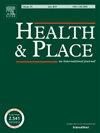Coal to swole: A survey of anabolic steroid use and muscularity concerns in coalfield areas of Wales
IF 3.8
2区 医学
Q1 PUBLIC, ENVIRONMENTAL & OCCUPATIONAL HEALTH
引用次数: 0
Abstract
Background
Growing male anabolic steroid use is often framed as symptomatic of a post-industrial masculinity crisis, but little quantitative evidence exists for this account. We examine whether steroid use is associated with geographic exposure to industrial decline, namely historical coal mining, and whether any association is mediated by masculine norms.
Methods
We fielded a quota-sampled survey of 18–49 year-old men in Wales (N = 1425). Data were geo-linked to the extent of historic coal mining locally to respondents. Generalised linear mixed models were fitted to test our hypotheses.
Results
Steroid use (odds ratio = 1.99, 1.10–3.60), but not body image (B = 1.06, −2.02-4.13), was positively associated with mining extent. However, this was not mediated by conformity to masculine norms.
Discussion
While use of steroids is more common in former mining areas, this is not due to more prevalent body image issues nor mediated by masculine norms. Thus, accounts of a post-industrial ‘thwarted masculinity’ do not fit the data. Steroid use in post-industrial areas is an issue for public health and these communities may benefit from targeted interventions to reduce risk of harms.
煤到肿胀:在威尔士煤田地区的合成代谢类固醇使用和肌肉问题的调查
越来越多的男性合成代谢类固醇的使用通常被认为是后工业时代男子气概危机的症状,但很少有定量证据证明这一点。我们研究类固醇的使用是否与工业衰退的地理暴露有关,即历史上的煤矿开采,以及是否有任何关联是由男性规范介导的。方法对威尔士18-49岁男性进行定额抽样调查(N = 1425)。数据与当地的历史煤炭开采程度相关联。采用广义线性混合模型来检验我们的假设。结果类固醇使用(比值比= 1.99,1.10-3.60)与挖掘程度呈正相关,而身体形象(比值比= 1.06,−2.02-4.13)与挖掘程度呈正相关。然而,这并不是以遵从男性规范为中介的。虽然类固醇的使用在前矿区更为普遍,但这并不是因为更普遍的身体形象问题,也不是因为男性规范。因此,关于后工业时代“受挫的男子气概”的说法与数据不符。后工业化地区使用类固醇是一个公共卫生问题,这些社区可能受益于有针对性的干预措施,以减少危害风险。
本文章由计算机程序翻译,如有差异,请以英文原文为准。
求助全文
约1分钟内获得全文
求助全文
来源期刊

Health & Place
PUBLIC, ENVIRONMENTAL & OCCUPATIONAL HEALTH-
CiteScore
7.70
自引率
6.20%
发文量
176
审稿时长
29 days
期刊介绍:
he journal is an interdisciplinary journal dedicated to the study of all aspects of health and health care in which place or location matters.
 求助内容:
求助内容: 应助结果提醒方式:
应助结果提醒方式:


